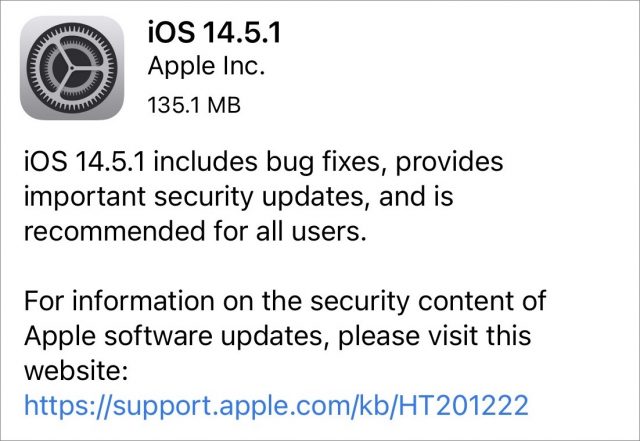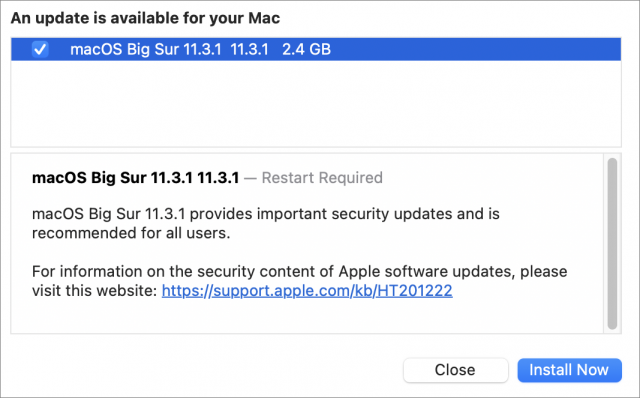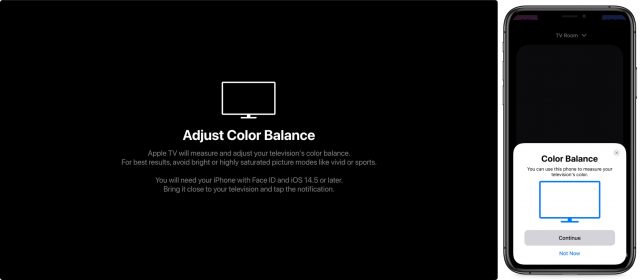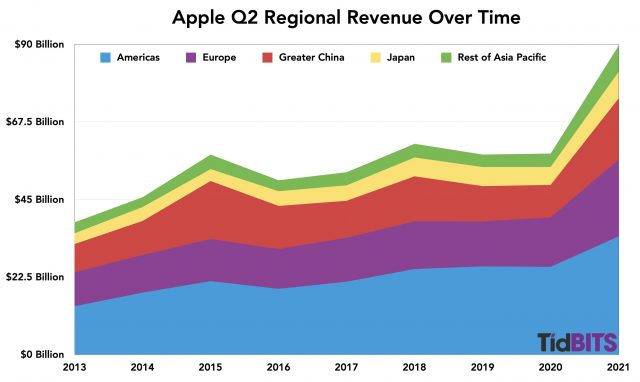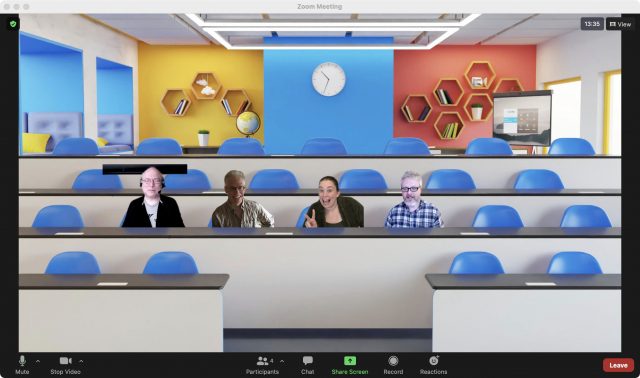#1561: More OS security updates, Apple’s huge Q2 2021, 10 Gbps Ethernet for M1 Mac mini, Color Balance in tvOS 14.5
A week after updating all its operating systems, Apple has pushed out iOS 14.5.1, iPadOS 14.5.1, macOS 11.3.1 Big Sur, and watchOS 7.4.1 to fix an App Tracking Transparency bug and a nasty WebKit vulnerability that may be in the wild. In a quieter update, Apple added 10 Gigabit Ethernet as a build-to-order option for the M1-based Mac mini. Josh Centers explains how to use the new Color Balance feature in tvOS 14.5 to quickly and easily correct color in video from the Apple TV. Finally, Michael Cohen and Josh break down Apple’s record-shattering fiscal Q2 2021. Notable Mac app releases this week include Security Update 2021-002 Catalina and 2021-003 Mojave, Pixelmator Pro 2.0.8, EagleFiler 1.9.4, BBEdit 13.5.6, Airfoil 5.10.3, Acorn 7.0.3, and Zoom 5.6.4.
Apple Releases iOS 14.5.1, iPadOS 14.5.1, macOS 11.3.1, and watchOS 7.4.1
Oops. Apple just released iOS 14.5.1 and iPadOS 14.5.1 to fix an important bug in iOS 14.5 and iPadOS 14.5. If you had already disabled Settings > Privacy > Tracking > Allow Apps to Request to Track, you may not have received App Tracking Transparency prompts from apps, even if you re-enabled the setting. We were wondering why we couldn’t get any apps to ask to track us.
Apple also released iOS 12.5.3, macOS 11.3.1, and watchOS 7.4.1. They, along with iOS 14.5.1 and iPadOS 14.5.1, fix nasty WebKit vulnerabilities that could lead to arbitrary code execution and that Apple says may have been actively exploited in the wild.
We’ll likely see security updates for 10.15 Catalina and 10.14 Mojave as well. They may be delayed while Apple fixes problems that Security Update 2021-002 Catalina created for apps that use OpenCL. There is no corresponding tvOS update because tvOS does not use WebKit.
Given the severity of these WebKit vulnerabilities, we recommend updating soon, whether or not you have already updated to one of last week’s updates (see “Apple Releases iOS 14.5, iPadOS 14.5, macOS 11.3, watchOS 7.4, and tvOS 14.5,” 26 April 2021).
To install the updates:
- iOS 14.5.1, iPadOS 14.5.1, and iOS 12.5.3: Go to Settings > General > Software Update. iOS 14.5.1 is 135.1 MB on an iPhone 11 Pro. iPadOS 13.5.1 is 92.8 MB on a 10.5-inch iPad Pro.
- macOS 11.3.1: To install the 2.4 GB macOS 11.3.1 Big Sur update, go to System Preferences > Software Update.
- watchOS 7.4.1: Install the watchOS 7.4.1 update from the iPhone’s Watch app in My Watch > General > Software Update. The Apple Watch must be on its charger and charged to at least 50%. The update is 63.1 MB on an Apple Watch Series 4.
As always, if you experience any problems after updating, please share that information in the comments to help other users.
M1-based Mac mini Gets 10 Gigabit Ethernet, Lights Out Management
Alongside the major hardware announcements from Apple’s “Spring Loaded” event was a silent update to the M1-based Mac mini. When that model first shipped last year (see “Apple M1 Chip Powers New MacBook Air, MacBook Pro, and Mac mini,” 10 November 2020), it came standard with Gigabit Ethernet, but with no option for faster speeds, unlike the Intel-based Mac mini. As we wrote:
The Intel Mac mini ships with a Gigabit Ethernet port by default, but for $100, you can kit it out with 10 Gigabit Ethernet. The M1 Mac mini offers no such option and is limited to Gigabit Ethernet.
Apple has now rectified that situation with a $100 build-to-order option that provides 10 Gigabit Ethernet. The M1-based Mac mini with 10 Gigabit Ethernet also supports Apple’s Lights Out Management settings that enable remote start, restart, and shut down for Macs enrolled in an MDM solution.
How to Use Color Balance in tvOS 14.5
Home theater nerds have long known that calibration is necessary to get the most out of your TV. Back in the day, that involved playing a DVD with test patterns and patiently cycling through them, making adjustments to brightness, contrast, and sharpness. Then came the fun part: using red, green, and blue color gels and more test patterns to fine-tune your TV’s colors.
You no longer need DVDs, as there are apps for the purpose, like THX tune-up, but if you own a modern Apple TV, you don’t necessarily need those apps anymore either. tvOS 14.5 has introduced a new feature, called Color Balance, that can automate the process of correcting the colors on video from your Apple TV (see “Apple Releases iOS 14.5, iPadOS 14.5, macOS 11.3, watchOS 7.4, and tvOS 14.5,” 26 April 2021). The feature is available on all tvOS-compatible Apple TV models: the Apple TV HD, first-generation Apple TV 4K, and the upcoming second-generation Apple TV 4K. However, you need an iPhone that supports Face ID.
Getting Started and Why You Should Turn Off HDR
To get started, update your Apple TV and iPhone to tvOS 14.5 and iOS 14.5, respectively. Color Balance calibration will fail midway if you have HDR enabled, so you’ll want to disable HDR on your Apple TV in Settings > Video and Audio > Format.
You might protest since HDR makes supported content look so vibrant, but here’s a tip from Take Control of Apple TV. Instead of enabling HDR in general, keep your TV on an SDR setting like 4K SDR, and instead turn on Match Dynamic Range in Settings > Video and Audio > Match Content.
When HDR is enabled all the time, the Apple TV tries to force HDR on non-HDR content, which looks weird (for example, the main menu looks washed out) and causes menu stutters and poor game performance. But if your TV (and HDMI cable) is HDR-capable, the Match Dynamic Range setting will turn on HDR for content that supports it. You get the best of both worlds!
Running Adjust Color Balance
On your Apple TV, go to Settings > Video and Audio > Color Balance. You see an onscreen notice instructing you to bring your iPhone closer to your TV.
In theory, you should see a pop-up on your iPhone prompting you to start the calibration process. I ran several Color Balance tests, and sometimes the notification wouldn’t appear at all. The only way I found to fix that was to exit the Color Balance screen on my Apple TV, restart my iPhone, and try again.
If the pop-up appears on your iPhone, tap Continue to start the process on your Apple TV. A sparkly iPhone outline appears on your TV screen. Hold the front of your iPhone about an inch away from your TV screen, inside the sparkly iPhone outline. Color Balance relies on the Face ID sensor.
Once the iPhone is in position and the iPhone and Apple TV are talking to each other, the iPhone outline will cycle through a range of colors. Hold the iPhone steady while this process completes. If you move the iPhone away (or forgot to turn off HDR), the process will fail.
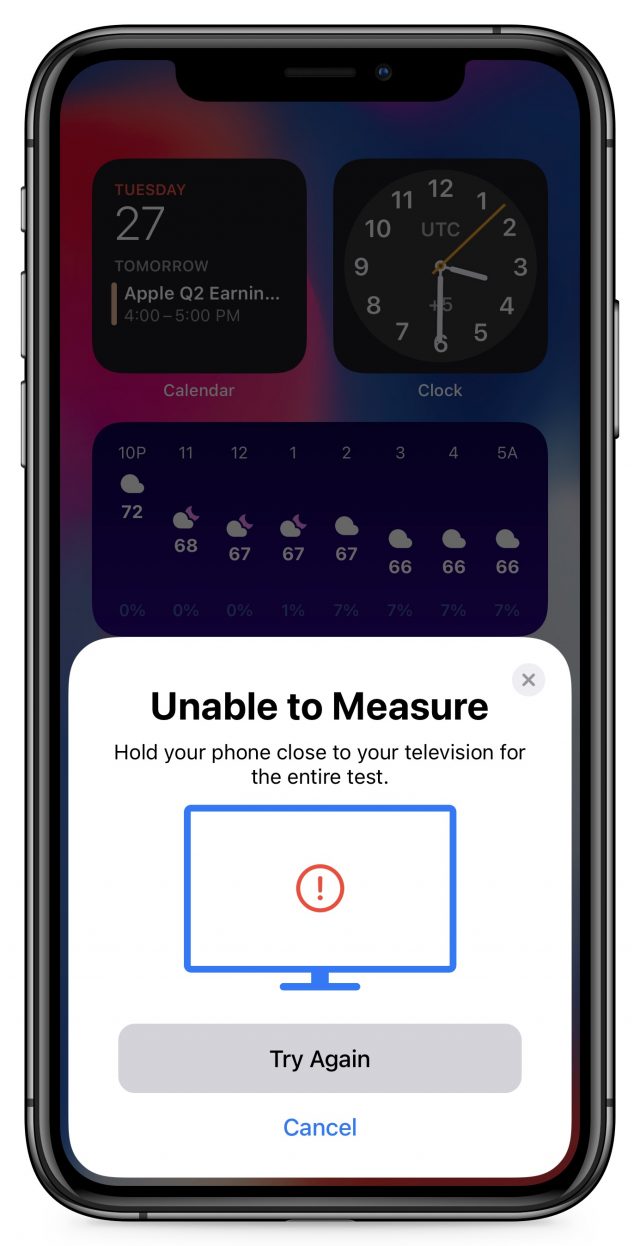
Once complete, click on the View Results button on your TV. It displays an overhead scene of a beach, and you can switch between Use Original and Use Balanced to see the difference between the two. The balanced setting will probably look a bit duller than what you’re used to since most TVs come out of the factory set to use overly saturated colors.
You can reset the color calibration at any time by going to Settings > Video and Audio > Color Balance. There, you see options to repeat the calibration, view the results again, or reset calibration.
Here are a few things to keep in mind:
- Color Balance corrects only color, not brightness, contrast, or sharpness.
- Color Balance doesn’t affect any settings on your TV. The color will be corrected only on video played from the Apple TV.
- If you change any display settings on your TV or change the Apple TV’s HDMI input (since many TVs remember separate settings for each HDMI input), you may want to run Color Balance again.
- If you move the Apple TV to another TV set, you’ll want to run Color Balance again.
There are also a few reports of the option not appearing or being grayed out. I don’t yet have any idea what causes this or how to resolve it beyond the usual recommendations to restart everything.
Color Balance may not make a huge difference, and it won’t change your life, but it’s a simple way to optimize the quality of video from your Apple TV. Between the new Siri Remote ditching gaming features and this new Color Balance feature, it appears that Apple is repositioning the Apple TV as the premier device for home theater enthusiasts.
Apple’s Jaw-Dropping Q2 2021 by the Numbers
Apple has announced Q2 2021 profits of $23.6 billion ($1.40 per diluted share) on revenues of $89.6 billion. The company’s revenues were up 54% compared to the year-ago quarter, and its profits were more than double the $11.25 billion that Apple reported for Q2 2020 (see Apple’s Q2 2020 Was a “Very Different Quarter” Than Expected, 30 April 2020).
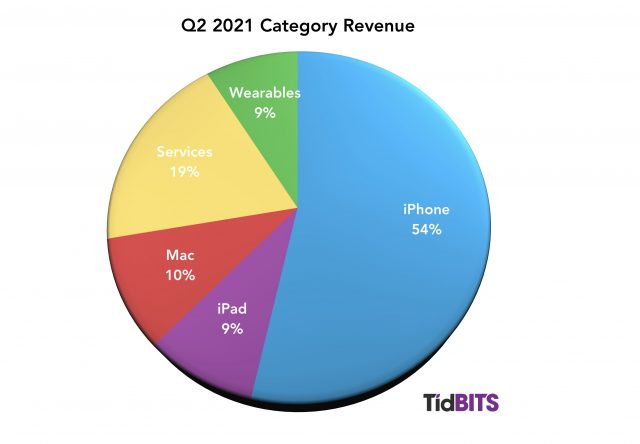 As has been the case for some time, iPhone revenues constituted more than half of Apple’s income for the quarter, but while the slice of the pie for each of the other categories was smaller than the iPhone’s, the pie itself turned out to be much larger than in past March quarters. For example, while Mac sales accounted for only about 10% of quarterly revenues this year compared to 9% last year, this year’s slice of the pie amounted to over $9 billion in income, besting last year’s Mac revenues by nearly $4 billion.
As has been the case for some time, iPhone revenues constituted more than half of Apple’s income for the quarter, but while the slice of the pie for each of the other categories was smaller than the iPhone’s, the pie itself turned out to be much larger than in past March quarters. For example, while Mac sales accounted for only about 10% of quarterly revenues this year compared to 9% last year, this year’s slice of the pie amounted to over $9 billion in income, besting last year’s Mac revenues by nearly $4 billion.
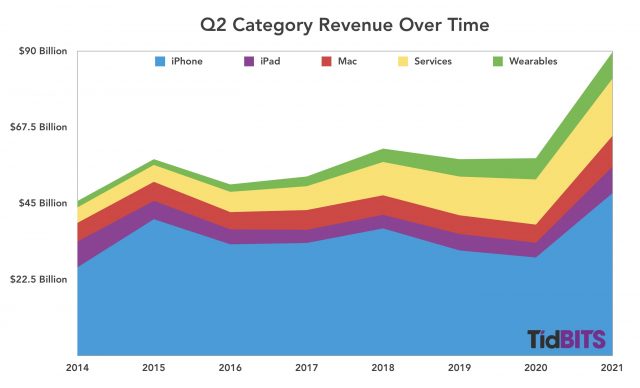 Let’s look at Apple’s sales categories. First, iPhone…
Let’s look at Apple’s sales categories. First, iPhone…
Hold onto your hat: the iPhone results are wild. iPhone sales increased 65.5% year over year. Yes, you saw that right. Apple raked in $47.9 billion in iPhone sales in Q2 2021, compared to $29 billion in the year-ago quarter. Cook credited the iPhone’s success to the “strong popularity of the iPhone 12 family.” To be fair, the delayed release of the iPhone 12 models also pushed a lot of its sales into this quarter’s results instead of them being realized in the previous quarter, which has been the pattern in prior years.
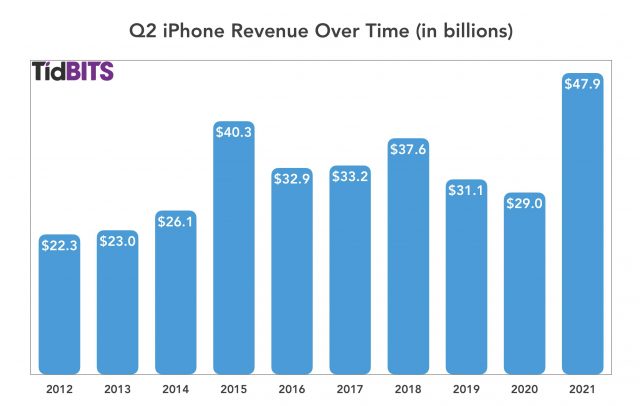 iPad quarterly sales increases year-over-year were even more astronomical: sales were up 78.7%. Although Apple sold “only” $4.4 billion of iPads in Q2 2020, the product line brought in $7.8 billion in Q2 2021. While this is not quite an all-time quarterly sales record for the tablet, the results were second only to Q2 2013, in which iPad sales hit $8.7 billion. As it was, iPad sales records still were smashed regionally: for example, Apple broke its all-time iPad revenue in Japan. Cook credited the iPad’s explosive growth to waves of people now working and learning from home. 50% of new iPad buyers in Q2 had never owned one before.
iPad quarterly sales increases year-over-year were even more astronomical: sales were up 78.7%. Although Apple sold “only” $4.4 billion of iPads in Q2 2020, the product line brought in $7.8 billion in Q2 2021. While this is not quite an all-time quarterly sales record for the tablet, the results were second only to Q2 2013, in which iPad sales hit $8.7 billion. As it was, iPad sales records still were smashed regionally: for example, Apple broke its all-time iPad revenue in Japan. Cook credited the iPad’s explosive growth to waves of people now working and learning from home. 50% of new iPad buyers in Q2 had never owned one before.
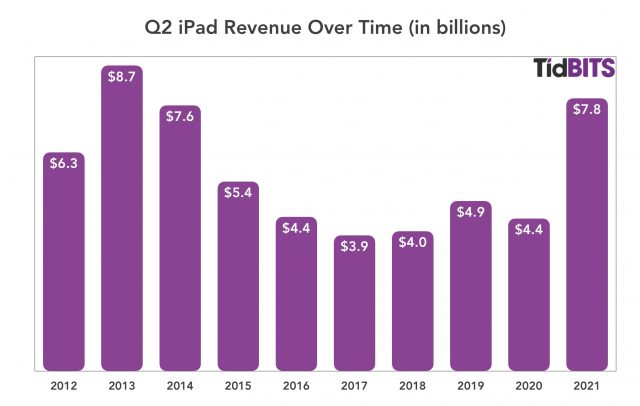 The Mac had its biggest Q2 by far since we started tracking it in 2012. It brought in $9.1 billion of revenue, a year-over-year increase of 70.1%, compared to $5.4 billion in Q2 2020. CFO Luca Maestri said that the past three quarters have been the best ever for the Mac. Cook credited the Mac’s current popularity not only to the many people working and learning from home during the pandemic, but also to the introduction of Apple’s M1 chip, which is replacing Intel’s chips in the Mac line. Like the iPad, half of all Mac buyers in Q2 were first-time buyers. The Mac set new all-time revenue records in Europe and Asia Pacific in Q2.
The Mac had its biggest Q2 by far since we started tracking it in 2012. It brought in $9.1 billion of revenue, a year-over-year increase of 70.1%, compared to $5.4 billion in Q2 2020. CFO Luca Maestri said that the past three quarters have been the best ever for the Mac. Cook credited the Mac’s current popularity not only to the many people working and learning from home during the pandemic, but also to the introduction of Apple’s M1 chip, which is replacing Intel’s chips in the Mac line. Like the iPad, half of all Mac buyers in Q2 were first-time buyers. The Mac set new all-time revenue records in Europe and Asia Pacific in Q2.
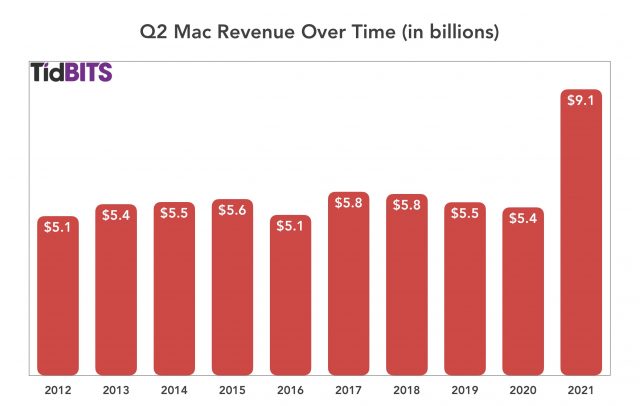 The Services category continues to grow, with a 26.6% year-over-year revenue increase, which seems small only compared to the astonishing iPhone, Mac, and iPad revenue increases. Services brought in $16.9 billion in Q2 2020, up from $13.3 billion in Q2 2021. Maestri said that Apple’s services now have 660 million subscribers. He added that all the drivers for Apple services are moving in the “right directions,” such as a large and growing customer base. Tim Cook also took a few opportunities to brag about the awards and nominations netted by Apple TV+ content, a small contributor to revenues but a substantial contributor to mindshare: he noted that the content service has garnered 352 award nominations and 92 wins.
The Services category continues to grow, with a 26.6% year-over-year revenue increase, which seems small only compared to the astonishing iPhone, Mac, and iPad revenue increases. Services brought in $16.9 billion in Q2 2020, up from $13.3 billion in Q2 2021. Maestri said that Apple’s services now have 660 million subscribers. He added that all the drivers for Apple services are moving in the “right directions,” such as a large and growing customer base. Tim Cook also took a few opportunities to brag about the awards and nominations netted by Apple TV+ content, a small contributor to revenues but a substantial contributor to mindshare: he noted that the content service has garnered 352 award nominations and 92 wins.
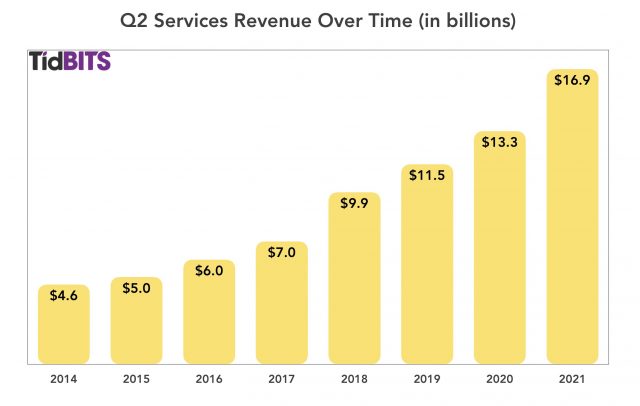 Wearables was the weakest category this quarter, increasing by “only” 24.7%. It brought in $7.8 billion during the quarter, up from $6.3 billion in the year-ago quarter. Cook said that 75% of Apple Watch sales in Q2 were to new Apple Watch owners. Although the closure of many Apple stores during the pandemic and the reduced services offered by others during this time may have adversely affected sales of some wearables, the online sales of wearables took up more of the slack than had been expected.
Wearables was the weakest category this quarter, increasing by “only” 24.7%. It brought in $7.8 billion during the quarter, up from $6.3 billion in the year-ago quarter. Cook said that 75% of Apple Watch sales in Q2 were to new Apple Watch owners. Although the closure of many Apple stores during the pandemic and the reduced services offered by others during this time may have adversely affected sales of some wearables, the online sales of wearables took up more of the slack than had been expected.
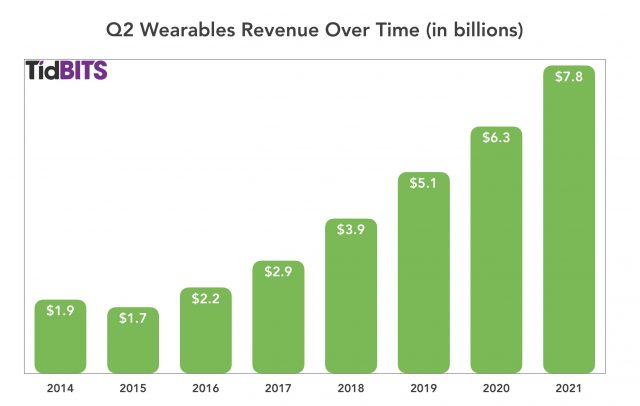 Apple performed well in all of its geographic sales regions, with revenues in every region increasing by at least 30%. Mac sales broke records in Europe and Asia Pacific, and iPad broke all-time sales records in Japan. In Greater China, where Apple sells a lot of goods, revenues increased from $9.5 billion in the year-ago quarter to $17.7 billion this quarter. Whether at home or abroad, Apple is doing very, very well right now.
Apple performed well in all of its geographic sales regions, with revenues in every region increasing by at least 30%. Mac sales broke records in Europe and Asia Pacific, and iPad broke all-time sales records in Japan. In Greater China, where Apple sells a lot of goods, revenues increased from $9.5 billion in the year-ago quarter to $17.7 billion this quarter. Whether at home or abroad, Apple is doing very, very well right now.
Where does Apple go from here? For one, don’t expect Q2 results next year to be as impressive as this year’s Q2. Last year, the March quarter was especially challenging, between the COVID-19 pandemic, its concomitant lockdowns, and supply chain issues. Apple had a lot of room to grow.
That said, Apple is on perhaps the firmest footing it has ever been on. The iPhone, iPad, and Mac are more popular than ever. The risky switch from Intel processors to Apple’s own M1 chip in the Mac has been nothing short of a smashing success, both critically and commercially. And Apple’s Services business seems to have unlimited room for growth. So, while Apple may not exceed these results next quarter—Cook noted that Apple would be “supply-gated, not demand-gated” in the coming quarter, having burned through much of its material reserves to counter supply constraints in Q2—the demand for Apple goods and services seems only to be accelerating, a prospect even sweeter than one of Ted Lasso’s famous biscuits.
